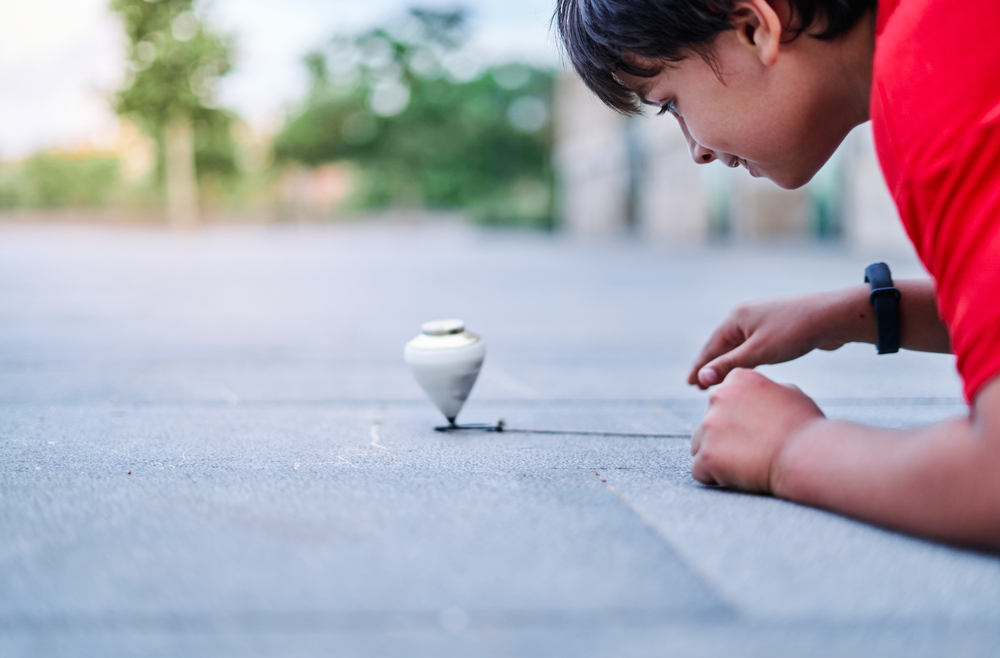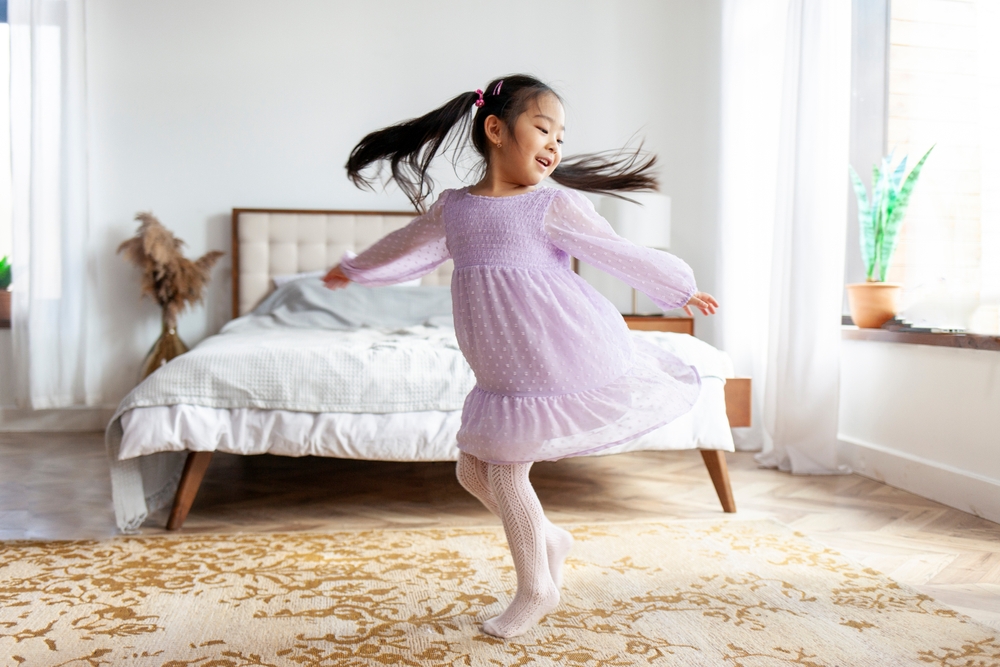It may involve twirling a marble and watching it spin, staring at a moving ceiling fan, or your toddler spinning in circles without end. All of these activities are examples of spinning. Many children enjoy spinning, whether it’s an object or themselves. This behavior is often observed in typically developing children and is considered a regular part of childhood.
However, according to research, 8.56 out of 10 children with autism spin. This is compared to 1.70 out of 10 with children with other delays. It’s due to this prevalence that parents of kids on the spectrum become concerned.
At Heartlinks, parents often ask, “Should I be stopping this behavior?” Our answers continuously vary, and there are reasons for that. Read on to learn more.
What Is Spinning?
Spinning is a self-stimulatory or stimming behavior. It is a natural self-regulatory behavior that occurs in everyone.
Neurotypical (non-autistic) children like to spin because it stimulates their vestibular system, which is located in the inner ear and helps with balance, coordination, and spatial awareness. Spinning provides sensory input that can be calming and help children feel grounded, especially when developing motor skills or exploring their environment. It is a natural expression of self-regulation and can serve many purposes, including improving concentration, emotional regulation, and simply releasing energy.
Your child isn’t necessarily autistic if they stim. Most stimming activities, such as spinning, are usually repetitive movements and quite common. Other examples of non-autistic stimming activities include:
- Tapping Fingers
- Bouncing Legs or Fidgeting
- Twirling Hair or Playing with it
- Fidgeting with objects
- Nail biting or skin picking
- Humming
Is Spinning a Sign of Autism?
Parents often ask us if spinning is always a sign of autism. No! Spinning is a common symptom of autism spectrum disorder (ASD), especially in toddlers and infants. But it’s not the only sign. In isolation, it doesn’t indicate a child is on the spectrum.
It’s essential to look for other signs of ASD, including:
- Extreme reactions to sights, textures, sounds, smells.
- Odd movement patterns and difficulty with coordination.
- Limited eye contact or not responding when spoken to.
- Difficulty adapting to routine changes.
- Fixation of an object or activity.
A toddler spinning in circles alone is not a definitive sign of autism. However, suppose this behavior occurs alongside other symptoms. In that case, it may be worth seeking a medical evaluation, which is crucial for understanding your child’s unique needs and accessing appropriate support and resources. Early diagnosis allows for early intervention, which can dramatically affect your child’s development.

A misdiagnosis, however, is not uncommon, especially when specific symptoms overlap with other developmental conditions. At Heartlinks, we can’t underscore the importance of consulting a trained specialist for a comprehensive evaluation. An accurate diagnosis ensures your child receives the right interventions and support tailored to their needs.
How Is Spinning Different for Autistic Children?
Non-autistic children usually stop stimming when they get a strange glance from someone or suddenly recognize that their behavior is drawing attention. However, because autistic children interpret body language and social cues differently, they may not pick up on others’ reactions to what they’re doing, thereby stimming in a situation where it’s considered socially unacceptable.
- Finger-flicking
- Hand Flapping
- Scratching
- Rocking back and forth
- Repeating words or phrases
- Finger snapping
- Covering and uncovering their ears
- Hard Blinking
Often, a neurodivergent child spinning serves the same purpose as a neurotypical child: regulating sensory input, self-soothing, coping with anxiety, and managing emotions. However, spinning might become more frequent and pronounced for a child on the spectrum due to differences in how they process information.
Why Do Autistic Children Spin?
Doctors believe that autistic spinning, which can also be called vestibular spinning, is related to a sensory processing disorder. Autistic children who regularly spin crave sensory stimulation or actively try to avoid sensory overload and are self-soothing. Depending on the type of response to stimuli, people can over- or under-respond to sounds, smells, lights, and textures.
For instance, a hypersensitive reaction might involve being overwhelmed by a strong odor, leading to sensory overload. An autistic child spinning around in circles might be a way for them to calm down or help distract from discomfort or pain.
Conversely, a hyposensitive reaction might be where a child actively seeks certain sensations because they’re understimulated. In that case, you might observe an autistic kid spinning to achieve a particular sensation.
What Are the Different Types of Spinning?
Object-Spinning: Examples of this stimming include watching a ball, hoop, or wheel spin in circles. An autistic child might also enjoy watching everyday machines operate, such as clothing on the spin cycle or salad being dried in a spinner. These activities
Full-body spinning: The most common version of this stimming type involves full-body spinning, in which the child rotates in a circle.
Leg Spinning: Where only the child’s legs are moving while they’re either seated or standing
Sideways Viewing: The child looks at objects from the side while slightly spinning the head.
Ritualized movement: involves a specific spinning pattern or route repeated while moving around.
Should I Stop My Child with Autism from Spinning?
Spinning and any type of stimming are not bad. To your child, these actions serve a purpose. However, when these repetitive movements interfere with everyday life, such as learning at school or participating in a social situation, it might be time to explore new strategies to manage or redirect the behavior.
One way we support families at Heartlinks is through parent training. This helps an autistic child’s loved ones and caregivers of autistic children, including those with low-functioning autism, understand how autism impacts the brain and influences behaviors like spinning. By gaining this insight, you’ll be equipped with realistic strategies to address these behaviors effectively and decide if intervention is needed.
Advantages of Stopping Spinning
It Can Make Social Situations Easier
Spinning can distract your child and others in social situations such as shopping with friends or attending a school dance. Autistic spinning, especially if you have an autistic teenager, can also ostracize them from their peer group and expose them to bullying or teasing. By curbing the spinning, your child can focus on communicating with friends, building social skills, and fitting in.
It Can Eliminate Self-Injurious Behavior
If your child enjoys spinning in circles but, while doing so, hits solid objects, it’s important to address the potential danger. From cuts, bruises, or worse, broken bones, this form of stimming may land your child in the hospital or seriously hurt someone else. Exploring alternate types of stimming and creating a safe space to spin will prevent more self-injurious behavior.
It Can Improve Your Child’s Focus and Attention Levels
Your child’s capacity to focus and pay attention in class, to others, and in general can be tremendously compromised by autistic spinning. Not only will it distract them, but it may also be so for others. In stopping the spinning, you’ll find your child can focus better at school and around others.
Disadvantages of Stopping Spinning
It Can Raise Anxiety and Stress Levels
For many children on the spectrum, spinning is the ultimate form of self-soothing. Whether it’s rotating on a chair or watching a ball turn on the floor, nothing calms them as effectively as spinning. To stop this spinning may raise their levels of stress and anxiety. It may also lead to depression because this is their most effective coping mechanism.
It Can Impede Your Child’s Self-Regulation
If your child is used to spinning to either self-stimulate or self-soothe and regulate sensory input, eliminating it as a coping mechanism could be harmful. Yes, there are less disruptive forms of spinning, but it may prove very difficult to teach your child those approaches, or they may be resistant. You may even discover that your child exhibits more challenging behaviors, including tantrums and public meltdowns, since halting the spinning.
How Can Therapy Help Your Child’s Spinning?
ABA Therapy (Applied Behavioral Analysis) is considered the most effective therapy for autistic children; ABA (Applied Behavioral Analysis) can be instrumental in helping with spinning. ABA therapy can do so much, from identifying the underlying sensory needs that trigger the spinning behavior to providing alternative or appropriate sensory activities, managing the child’s need for stimulation, and teaching coping strategies.
Understanding the Spinning Triggers
From a diagnostic point of view, a trained and certified ABA therapist can identify the triggers that cause spinning, whether hypersensitivity to bright lights, stressful situations, or something else.
Provide Alternative Sensory Activities
Once the triggers are understood, an ABA therapist can introduce alternative, appropriate sensory activities, such as bouncing or specific movement exercises, to meet the exact needs of the patient’s vestibular stimulation.
Teaching Coping Strategies
If your child’s autistic spinning has become excessive, the following are the different ABA techniques a therapist might use to help.
- Shaping: Gradually teach the child to use props like a sensory ball or swing rather than spinning, rewarding them every time they do so.
- Tacting: This approach involves instructing the child to identify and communicate their sensory needs, such as saying, “I need to move.”
- Positive Reinforcement: Rewarding the child with praise or a favorite activity when they use an alternative coping strategy.
- Punishment: In rare cases, if spinning has become unsafe or aggressive, redirect with a firm “no” and lead them to safer behavior.
- Error Correction: If the child begins to spin inappropriately, gently interrupt the behavior and guide them to the desired alternative (e.g., “Let’s try the wobble cushion instead”). Reinforce the correct behavior once the child engages in the appropriate activity. This ensures the child learns what is expected and associates the correction with a constructive alternative.
By combining these ABA techniques and some at-home ABA methods for parents, you can address spinning behaviors in a supportive, respectful, and effective way for your child’s development.
Heartlinks: Supporting Families Through Every Step
There’s a beautiful quote from a parent of an autistic child that says, “We may not have it all together, but together we have it all.” At Heartlinks, we strive to be a part of your family’s “together” by offering a range of compassionate and personalized ABA therapy services. Whether you’re searching for in-home ABA therapy for your child’s spinning or navigating the early stages of a diagnosis, we’re here to support you.
Reach out to Heartlinks today to learn how we can help your autistic child thrive and address any other concerns you might have.
